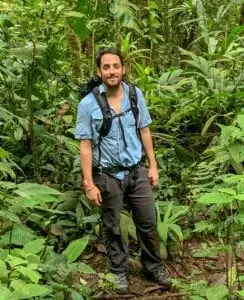Home » Conservation » Amos Bien – The Man Responsible for Eco-Tourism in Costa Rica

[February 2, 1951 – November 19, 2017]
Amos Bien may have been born in New York City, but his heart seems to have come alive in Costa Rica. This love affair began as a graduate student working on his thesis back in 1979, and the relationship grew over the four decades while finding ways to keep the rainforest intact and helping the local economy with sustainable projects.
In 1983, Amos was working at a biological station in the Sarapiqui region of Costa Rica, where every day he heard chainsaws destroying the rainforest around him. His colleagues said it was big corporations clearing the forest, but as a scientist, he had to investigate. He discovered it was a group of low-income farmers who had a dream of becoming wealthy cattle ranchers. (1)
Knowing that the rate of deforestation was not sustainable, he realized how important it was to help local farmers find ways to create income without destroying the valuable natural environment. But he realized it was not affordable to reach their dream without financing, which was not easily obtained at the time.
Working with locals and sympathetic funders, they began the project of building Rara Avis, the first real ecolodge in Costa Rica, while at the same time, keeping the rainforest undamaged. It has become a model for eco-tourism around the world.
While academically trained as a population ecologist, Amos became a pioneer in sustainable tourism and a leader in helping to establish guidelines and criteria for sustainable tourism certification. (2) (3) (4) He agreed with the concept that “Eco-tourism could be considered as a ‘well-meaning’ term, which was devised with the best of intentions.” (5) But there was plenty of “green-washing” going on in the tourism industry.
Working with the Global Sustainable Tourism Council, Amos was a lead consultant for creating standards for the tourism industry where he could share his results in Costa Rica with more of the world. The Global Sustainable Tourism Criteria gives a set of global baseline standards for sustainability in travel and tourism.
Amos and fellow colleagues, all of whom are passionate about saving the world’s rainforests and natural spaces, worked together to create this much-needed common language about sustainability in tourism. It is used as a basis for certification in the areas of sustainable management, and socioeconomic, cultural, and environmental impacts (including consumption of resources, reducing pollution, and conserving biodiversity and landscapes). (6)
In 2009, Amos wrote “Guide for Tourism: An Environmental and Social Management Instrument” as part of the project: “Environmental Impact Assessment in Central America: A Tool for Sustainable Development.”(7) Instruments provided can be used as tools to reduce the pressure realized by the Environmental Impact Assessment administrative system, which was overloaded due to large numbers of moderate impact projects in Central America. These projects accounted for 80% of the system entries.
By using these types of instruments as a means to assess environmental impacts, the overall EIA process will be expedited, thus freeing the staff to carry out field monitoring and control activities in order to focus on the actual outcomes and impacts on the environment rather than on the paperwork. This means an important change in the EIA procedures which will reduce the administrative processes to generate greater changes by involving individuals and developers more actively in environmental management. (7)
Overall, the purpose of the instruments provided in the guide is to improve the productive relationship between the natural environment and the community – which symbolizes two areas in which Amos Bien was passionate.
Creating sustainable tourism requires money, and those living a subsistence lifestyle within and around the Costa Rica rainforest did not have access to funds for sustainable projects. Amos worked with the United Nation’s environmental programs on sustainable tourism issues to form the Global Sustainable Tourism Partnership and Sustainable Investment and Finance on Tourism initiative. (8)
A key objective of the Global Partnership is to provide guidance for developing sustainable tourism projects, promote sharing of best practices and encourage reporting of demonstrable results. To this end, the Global Partnership serves as a clearinghouse for sustainable tourism projects. (8)
The core service of the Global Partnership provides the much-needed technical assistance to countries like Costa Rica, and advice to assist in the development and implementation of sustainable tourism projects.
The work of Amos Bien contributed to the successful recovery of the rainforest in Costa Rica, and his work stretched across the globe, as shown above in just a few of the projects he joined over the last four decades of his life.
In 1983, when he heard the chainsaws, the rate of deforestation was at 50,000 hectares per year and forest covered only 26% of the country. By 1989, that number dropped to 22,000 hectares, and by 1994, it plummeted to 4,000 hectares. In 1998, the deforestation rate dropped to zero, and in 2020, Costa Rica was back up to 52% forest coverage.
Costa Rica is often viewed as one of the most successful eco-tourism places in the world. For instance, in 2010, Costa Rica generated more revenue from tourism than from cattle, coffee, and bananas combined. (9)
And thanks to the work of Amos Bien and his colleagues, there is hope for sustainable tourism around the world.


Founder of Grow Jungles